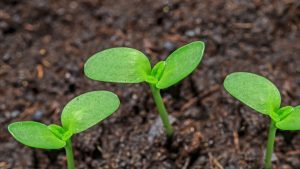If you sow and grow your plants yourself, you may have already had the experience that some seeds don’t want to germinate. Pre-germination can help here. With this process, it is easier to create optimal conditions for the roots and thus facilitates germination. Celery or parsley, for example, are true mimosas and benefit from pre-sprouting. But the short procedure is also worthwhile with tomatoes, chili, peppers, and aubergines.
How exactly a seed is pre-germinated depends on the type of seed, the germination conditions, and the number of sources. Depending on the variety, seeds need very different conditions to germinate. In our article “The 8 best sowing tips,” we go into this shortly: Temperature, humidity, and planting depth are essential. You can ignore the planting depth until the seeds have germinated. Light doesn’t play a role either. Your source does not care about the lighting conditions as long as no seedling has “hatched” that could perceive the difference between light and dark.
WHEN IS IT WORTH PRE-GERMINATING SEEDS?
There are various reasons to resort to the pre-germination procedure. Sometimes due to time constraints. Sometimes it is particularly economical with rare seeds. Or because the seed would not germinate at all without some preparation. If you are not sure whether you should pre-germinate your sources for good seed success, then take a look at our article: “When it is worth pre-germinating seeds.”
Either way, pre-germination is a lot faster than normal sowing. Since all germination conditions can be met more easily during pre-germination, the germination phase is shorter. The ideal temperature for germination is critical, which often saves waiting a few weeks. Even if the seed is only two or three degrees cooler than the perfect temperature dictates, germination will be delayed by days.
Hurry, gardeners can also before that the seeds are also edited. For seeds such as zucchini or pumpkin, this method was recently highly praised on US forums.
HOW SEEDS ARE PRE-GERMINATED
The good news is: you can ignore the seed depth for now. For this, you have to pay careful attention to constant moisture and compliance with the germination temperature.
The following applies: humidity and temperature are the most important things! Whether a seed germinates or not depends on whether it initially has enough water to swell. The water virtually brings the roots back to life: the cells suck themselves in and project, the softened seed coat finally bursts open, and the seedling breaks out. As soon as the temperature of the surrounding medium (mostly soil) has reached the right temperature, the seedling can grow. Both factors are critical: The bursting seedling will rot if it stays too cold for too long. If the seed dries up after bursting, the seedling will also die.
Pre-germination is an excellent way of increasing our chances of success in this critical phase. Maintaining the correct temperature is undoubtedly the most challenging part. First of all, you need to know the right temperature. For purchased seeds, the ideal germination temperature can be found in the sowing instructions on the packaging. We have also put together a list with the perfect germination temperatures for 68 vegetable and herb varieties. The values always relate to the temperature of the seed medium, not to the temperature of the air.

Bottom Line
The ideal temperature does not have to be reached exactly, but the process takes correspondingly longer. 2 degrees less means an extension of the germination time of over a week. The ideal temperature should not exceed more than 3 to 4 ° C, which also affects the germination capacity. It would help if you tried to keep the temperature even. Of course, there is special equipment for this, such as electric heating mats or heated mini-greenhouses. But seeds can also germinate successfully with simple means!
Find the warmest places in your home; a good site often above the refrigerator, where the warm exhaust air discharge. Various lamps also generate noticeable warmth when you move your hand close to the lightbulb. If you don’t mind leaving the light on for a day or two, this is how you warm up the seeds. Caution! Make sure it doesn’t get too hot, and the roots don’t die. Even more critical: Avoid the risk of fire in any case!
Cold bridges should also not underestimate. Natural stone window sills, for example, often such cold bridges, even if they installed over a heater. Just test by laying your hand on it. Any place that feels slightly warm but not hot is good enough when in doubt.
Also read: how to make mead



l7iquo